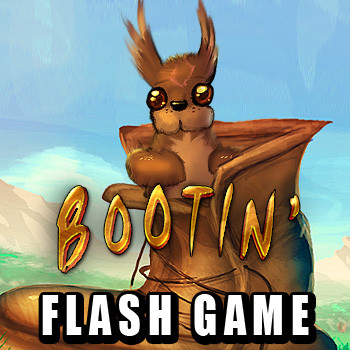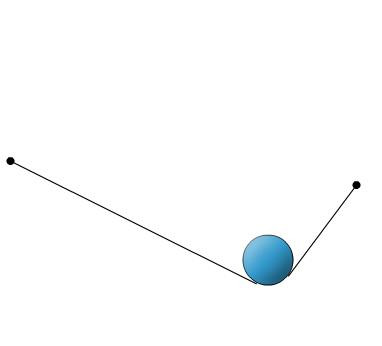HOME | DD
 DovSherman — Wa-Tor: An Ecosimulation
DovSherman — Wa-Tor: An Ecosimulation

#dewdney #ecology #ecosystem #simulation #ecosim #ecosimulation
Published: 2005-11-26 21:42:40 +0000 UTC; Views: 36711; Favourites: 93; Downloads: 1224
Redirect to original
Description
Based on an article by A. K. Dewdney ("Sharks and Fish on the Planet Wa-Tor"), this is a simple ecology simulation.In this simulation, fish swim and reproduce while sharks swim, reproduce, and eat the fish.
About the parameters...
Breed Time: How old a fish or shark needs to be before it will reproduce. (On Wa-Tor, fish and sharks all reproduce by parthenogenesis, like amoebae.)
Starve: How long a shark can go without eating before it will starve to death.
Initial Population: The total number of each species with which to start the simulation.
World Size: The world wraps around so that, when a fish or shark swims off an edge, they come back on the opposing edge. The world can be anywhere from 2x2 to 20x15.
What parameters will provide a self-sustaining eco-system in which the sharks never hunt the fish to extinction but never starve to extinction themselves?
The original program Dewdney described in the article, back in the mid-1980's, used a simple text display in a grid with 0 . and * to indicate sharks, water, and fish.
Update: The simulation has been updated to remove the upper limit on world size. Very large worlds may cause the simulation to slow down but think about experimenting with the effect using larger worlds or long, thin worlds.
Related content
Comments: 43

I was able to go 2459 time with the original settings.
👍: 0 ⏩: 0

Sharks: Breed=10 Starve=5 In Population=30
Fishes: Breed=1 Population=120
Size: 40x20
They were alive (sometimes almost enxtinct, but still alive) for a few hours until I just stopped it D:
👍: 0 ⏩: 0

I got An Infinite Cycle. Set:
Shark
Ini. Pop: 1
Starve: 1
Breed: Some really big number
Fish
Breed: 1
Ini. Pop: 4
Size: 2x2
👍: 0 ⏩: 0

The first time I played, the sharks went extinct at 804 seconds.
👍: 0 ⏩: 0

Have you had any requests from fish scientists or biology teachers to do other simulations? This could be a very good learning tool.
👍: 0 ⏩: 0

Very interesting. In my case sharks got overpopulated, the fish almost got excint, but then most sharks starved to death so fish started populating again. And then sharks got overpopulated again, and it became a big endless cycle.
👍: 0 ⏩: 0

it seems as if this could be rather useful for some science classes, because of the way it shows the basic predator-prey patterns (Predator rises, prey falls, predator falls, prey rises, predator rises......)
👍: 0 ⏩: 0

i parameters wich will make it last forever or at least that long that you cant watch it till the end
shark
ini. population 1
starve 1
breed 9999999²³³ or something less but still incredible high
fish
ini. population = rest of tiles
breed 1
👍: 0 ⏩: 0

Over 4000 seconds~
Fish:
Breedrate- 2
Original population- 120
Sharks:
Breedrate- 20
Starve- 1
Original population- 40
Size: 40 X 15
👍: 0 ⏩: 0

I think that I have success fully made an ecosystem that won't die!
Fish:
Breed rate: 1
original population: 550
Sharks:
Breed rate: 20
starve rate: 5
original population: 90
I'll stay 'til they die...
👍: 0 ⏩: 0

what a perfect simulation! I've tried that, but the predator or the prey always died out... How did you do that?
👍: 0 ⏩: 0

one of the greatest biological simulations I've ever seen
amazing job
👍: 0 ⏩: 0

Time: 1500
15 sharks
450 fish
this is so cool! OH MY GOD!!!
I can't believe they've lasted so long!
I just changed the sharks to starve after a day and they're all thriving!
Shark's fluxuation: 13-110
Fish fluxuation: 44-550
(Fluxuations are approximate, just passed 2000 time)
OMG definite fave!
WOOT!
👍: 0 ⏩: 0

I got my fish population up to 517 with the default parameters. That's 30 more minutes of my life gone. XD Good job!
👍: 0 ⏩: 0

This assumes that sharks eat as much as they possibly can, that if the resources are available they will eat every move. Anyway, that makes the system easy to manipulate. A single shark is placed in apopulation of 50 fish, it breeds every seven moves while fish breed after every 1 move. The shark starves unless it eats within 1 move. (Default size.) The population is self sustaining if it starts off well, but it moves so erratically (it either can't be real or is all too real). Anyway, the system just seems so easy to manipulate. With quick-breeding fish and quick-starving sharks its almost guaranteed to succeed.
👍: 0 ⏩: 1

That's a good point. But finding the "right" parameters doesn't necessarily mean simply providing a very long-running ecosystem. It means finding providing both a long-term ecosystem AND one in which behavior is plausible.
I find that some good parameters would have the fish to breed very quickly and that sharks should starve at a slower rate than fish breed but not too much so. Shark breeding should be around 3 times as slow as shark starvation. Of course, that's just one variation on the parameters and the shape of the environment (small, huge square, long-thin rectangle) can have a big effect as well.
👍: 0 ⏩: 1

For the behavior to be plausible the breeding of fish would have to be adjusted with environment (breeding more when there are fewer of them and less when there are more of them) so that they don't fill up the screen. A steady ecosystem might be acheivable if there is a third factor of resources available allowing the fish to breed (or if the sharks did not eat every chance they got, which would not be necessary if they starved long after eating), although I'm not sure if available resources (plants to be precise) could help control the ecosystem or if they would simply complicate the system and make it even more unstable. For this it seems the most plausible behavior pattern is cyclical behavior, which is precisely what is acheived (besides that, in some ways it simulates seasonal fluctuations in the form of spikes and low points from which it rises).
👍: 0 ⏩: 1

The breeding of fish *is* adjusted with the environment because when there are lots of sharks, fish get eaten up and that means fewer fish to breed. Two many fish makes the sharks more likely to survive and breed until their are lots of sharks which eat up too many fish and sharks start starving until they drop down in numbers supportable by the remaining fish. Then the fish, having fewer predators and more room, start to increase in number again and the cycle continues.
👍: 0 ⏩: 0

Whoa.. I could sit here for hours and HOURS and never get bored. o.o'
👍: 0 ⏩: 0

This is seriously cool. Its was great to watch the populations fluxuate in patterns. Patterns that grow so extreme that is results in the extinction of one species, in the case I watched, it was the sharks. Really cool simulation.
👍: 0 ⏩: 1

The way I have it, when the sharks go extinct, the simulation immediately stops. If the fish go extinct, it keeps going. Of course, if the fish go extinct, the sharks will soon follow since they'll have nothing to eat. But if the sharks all go extinct without killing off all the fish first, if the simulation didn't stop, the fish would simply grow and grow until the fill the world with no more room to move.
👍: 0 ⏩: 1

Makes sense. Really well thought out, what was your inspiration to do a flash project like this?
👍: 0 ⏩: 1

I was just browsing a book on my shelf and thought it might be fun to try putting some of the experiments described into a Flash format. The book, "Armchair Universe" by A. K. Dewdney, is a collection of articles, many of which were previously published in the Computer Recreations section of Scientific American. There's a lot of nifty stuff in there like perceptrons, tesseracts, fractals, life, facebender, and so on. I'd also recommend Dewdney's "Magic Machine" and "The New Turing Omnibus" which have an even greater variety of interesting computer experiments.
👍: 0 ⏩: 1

Those books sound interesting. I have a few questions. 1) Does the "Armchair Universe" book include infinite regression? A common example, in case you're not sure, is place two mirrors parallel and facing each other, and if you look in either mirror, you can see reflected in it what looks like an unlimited number of mirrors. There was an article on that in S.A. a while ago, and had a neat infinite regression of the S.A. cover picture on the cover.
2) Is tesseract the same concept as how the characters in A Wrinkle in Time use to travel?
3) I've never heard of perceptrons, and I'm not sure what facebender is. Can you give me a quick description of each?
4) I've also been trying to find out about antimatter. I know it's the opposite of matter, but can you tell me if it actually exists, and if so, where (is it everywhere or not on Earth), and what might it look like?
I also have a question about the 4-D hypercube you uploaded. Isn't the fourth dimension time? How do you draw a shape that represents that?
Thanks, Dov(e), for your time, and you have some interesting posts this time around!
👍: 0 ⏩: 1

The three books by Dewdney that I mentioned all deal with mathematics and computer science, often with computer simulation, which is fitting since Dewdney himself is a mathematics/compsci university professor. I don't know if infinite regression would apply. It doesn't appear to be covered specifically although the concept of infinity is certainly raised a number of times.
I haven't read "Wrinkle in Time".
The idea of time as a fourth dimension has been around since the 1700s when Jean le Rond D'Alembert suggested thinking of time as a fourth dimension in an article published in the "Reasoned Encyclopedia or Dictionary of Sciences, Arts, and Crafts". Of course, in a Tesseract, we're treating the four dimensions as spatial dimensions so, while the mathematics may apply well to time as a fourth dimension, it's hard to conceptualize rotating through time since we humans don't really concieve our experience time in the same way that we experience space.
Keep in mind that just because I'm using four dimensions, that doesn't necessarily mean that one of them is time. Time is often called "the fourth dimension" in the sense that Newton's physics knew about three spatial dimensions and then was expanded to add the use of time as another dimension. In that sense, time is only "fourth" because we noticed it after the other three. But there is no real reason to assume that dimensions have to be listed in any particular order or that there are only four.
In mathematics, a dimension can be any value which can be varied. For example, you can consider colors on your computer screen to be 3-dimensional with the dimensions being redness, greenness, and blueness. Include the alpha channel and a computer image may be 4-dimensional. Add normal mapping and a texture used in 3D rendering may be 7-dimensional with 3 colors dimensions, one alpha dimension, and 3 more dimensions to define the surface normal.
A perceptron is a computer algorithm that can percieve. For example, optical character recognition (the way your computer scanner can turn a scanned image of text into a text file).
Facebender was a project using computer-simplified representations of human faces. One applications were to find the average human face and use the average to extrapolate charicatures of specific faces by exaggerating any differences from the average face.
Anitmatter is the time-reversed analogue of matter and such matter travels faster than light and can never slow down below the speed of light so it wouldn't look like anything since you can't possible see it. Some of antimatter theory is theoretical but there is fairly solid evidence for some of it, such as tachyons. I could be a little mixed up on this one though - I'm not well versed on antimatter.
👍: 0 ⏩: 2

Thank you for taking the time to respond and answer my questions.
I thought you might have read "A Wrinkle in Time." You really should, it's a great and really interesting book. Madeleine L'Engle is an amazing author; I've read several of her books, and have more that I haven't yet read. No matter, though. I can describe tesseract in the way the L'Engle uses it. Like I said before, that's how the characters can travel. Here's an example, it's also the example the book uses to describe it, so I guess L'Engle has copywright here: Think of an ant traveling on a string. One end of the string is point A and the other B. What tesseract does in this instance is "bend" the string so that points A and B are touching each other, and the ant can then travel directly from A to B. The book also described tesseract as the fifth dimension. What are your thoughts on this?
👍: 0 ⏩: 1

Well, a tesseract only have four dimensions, not five. I suppose it could be treated as a way to bend space but the only way such an A/B overlap would occur were if the fourth dimension were removed from the geometry, collapsing the tesseract back into a cube. Does the author describe the tesseract as being folded or distorted somehow?
👍: 0 ⏩: 1

Ok, let me see... I have the book in front of me. One of the characters in the book says that they are going to tesser. That must be the verb form, if there was one. She says that traveling at the speed of light is taking the long way around, that she likes to take shortcuts. Then she takes one of the other characters' skirts and gives the straight and bending line demonstration. She also describes it as going beyond the fourth dimension to the fifth. Then another of the main characters goes through the dimensions.
The first is said to be a line.
The second is a square of that line.
The third is a square of the second.
For the fourth and fifth, here is what Madeleine L'Engle wrote. "Well, I guess if you want to put it into mathematical terms you'd square the square. But you can't take a pencil and draw it the way you can the first three. I know it's got something to do with Einstein and time. I guess maybe you could call the fourth dimension time."
"...Okay, then, for the fifth dimension you'd square the fourth, wouldn't you?"
"I guess so."
"Well, the fifth dimension's a tesseract. You add that to the other four dimensions and you can travel through space without having to go the long way around. In other words, to put it into Euclid, or old-fashioned plane geometry, a straight line is not the shortest distance between two points."
One of the characters says that though the group travels together, they each travel alone. L'Engle gives a description of what one of the tessering characters feels in the process. She says that the character felt a gust of wind and a great thrust and a sharp shattering as (she) was thrust through something. Then darkness; silence; nothingness.
That's all the author says about it. Does this answer your question about the folding or distortion?
👍: 0 ⏩: 1

Not really. It's possible that this is an incomplete description but, from this small excerpt, it doesn't sound like L'Engle is describing a tesseract or four-dimensional geometry with any logical connection to mathematics. It's kind of like the scientific pseudobabble you get on Star Trek where they throw in a lot of scientific terms that sound good in a story to the average person but don't actually make sense if you're well-versed in those terms.
👍: 0 ⏩: 0

Slightly mixed up. Granted, I only know of anti-matter from school (my senior year high school teacher to be precise) and some independent study, but first there is a certain particle which can only travel faster than the speed of light and cannot slow down below the lightspeed barrier. This particle, like every other has its anti-matter particle. The theory is that matter came out of a vacuum which was the universe, as a result there was a hole in the universe and this hole is anti-matter. Anti-matter looks and acts exactly like actual matter (it has been seen and collected, but it is destroyed as soon as it comes into contact with a particle or matter), the only noted difference so far is that it usually has a reversed polarity (although this does not hold true for particles which are found with both or no polarity). I have heard there is a way to tell whether one is seeing matter or anti-matter, but I don't know what it is and I think this assumes that we are made of matter anyway when it is quite possible that we are composed of anti-matter (we are nothing more than holes in the universe). Also, once anti-matter is produced it can be held in place by strong magnetic forces (which i have heard of an experiment where a fairly large quantity of anti-particles were held in place and shot out in a beam at a group of matter within this controlled area, about the only thing that can be done with it).
👍: 0 ⏩: 1

I follow you but, if anti-matter isn't time-reversed (like tachyons which travel backward in time and experience temporally-reversed causality) what is it about anti-matter that earns it the prefix "anti"? Does it have negative mass and anti-gravity?
I was thinking that, if anti-matter were time-reversed, it would explain the annihilation effect without violating the "matter can be neither created nor destroyed" concept. When an electron and anti-electron meet, they annihilate each other, leaving nothing behind. But if the anti-electron is going backward in time, it would only seem to disappear from our viewpoint. From the anti-electron's viewpoint, it's just coming into being and may in fact simply be the electron reversing its direction in time. So what seems like two particles annihilating each other may actually be one particle changing time direction.
👍: 0 ⏩: 1

The only tangible difference as far as I know (aside from the annihilation and polarity where applicable) I think would be the spin. If I am not mistaken, when an electron and anti-electron (positron) are released, the electron spirals clockwise while the positron spirals counter-clockwise. At least that is a picture I once saw where each particle's paths were traced.
It is quite possible that anti-matter is time reversed, but I am not sure this would not be acheived by going over the speed of light. I would think that if one were to reach a velocity of infinity on a spaceship, one would reach their destination at the same point in time which one reaches the infinite velocity. Thus, everything leading up to this velocity of infinity must cause a shorter amount of time to pass from the perspective of the ship, while from the perspective of the planet the amount of time elapses as though it were traveling at the speed of light. Maybe I am slightly confused, but if I am not mistaken one still ages when traveling at the speed of light, just much more slowly than usual.
Anyway, I was thinking of the implications of anti-matter being time reversed. Even though a particle and anti-particle annihilate each other, they cause a large amount of pure energy to be released. It is also true that in order to form a new particle and anti-particle a large amount of energy must be focused in a small area and this then translates to a particle forming along with its anti-particle. Anyway, the implication I was thinking was that this points in some manner to the existence fate. If a particle and anti-particle combination were created before quickly colliding and annihilating and the anti-particle has a different time orientation, then it could be said that the annihilation of the particle was the formation of the anti-particle while formation of the particle was the annihilation of the anti-particle.
Fate comes into play in that before when the particle was created, a certain level of energy had to be acheived, perhaps even the same level of energy that was caused by the particle/anti-particle annihilation. If the anti-particle is time-reversed than it forms from the annihilation of the particle (which also causes a large burst of energy) and is annihilated at formation of the particle. But if the energy used to create the particle and anti-particle was the same as the energy released from their annihilation, then the annihilation could have been said to have caused the burst of energy while the energy causing their formations had essentially already happened because it was a result of annihilation and the accumulation of energy in that single point was a reversal of the process of the energy dispersing.
The theory of matter and a hole left in the vacuum doesn't violate conservation of energy (matter is an organized form of energy). In order for the particle and anti-particle to form there must be a large amount of energy focused in a single area which causes a particle to essentially pop out of the vacuum (possibly the smaller, simpler (theoretical if not hypothetical) particles which would then give rise to more complex particles as an electron) and leave behind a hole which is the anti-particle. The rise of the particle and anti-particle therefore are the transfer of energy from a raw form (gamma rays to be precise) to a much more organized and usable form. It is possible the anti-particle has a reversed time orientation although from our perspective this would not be noticeable unless we were observing a structure larger than a particle.
👍: 0 ⏩: 1

Setting aside the relationship between anti-matter and time-reversal....
Your thinking in regards to infinity is good but it doesn't require infinity. All proofs seem to support the idea that this is a relativistic and that means that the speed of light is the absolute limit. As the speed of an object approaches the speed of light, time dilation increases. In theory, if an object were to actually reach the speed of light, time would effective stop for that object and it's mass would reach infinity. Which means it can't be done. Graphing this relationship places an asymptope at the speed of light.
Now, another interesting thing about this is that the asymptope has two sides. It is entirely possible for an object to go faster than the speed of light. However, an object which is going faster than light would never be able to slow down below the speed of light. Tachyons, for example, are faster-than-light particles. They only travel faster than light and can never slow down below the speed of light. They experience causality in the reverse temporal direction from sub-light matter. Whether this temporal reversal is an inherent property of FTL matter, I'm not sure.
On the subject of fate, Minkowski's 4-dimensional model for space-time in a relativistic universe suggests that time can be treated as a geometric dimension. If this is correct, it suggests that the past and future are already laid out as the 4-dimensional topology of the universe which supports the idea of a completely deterministic universe. You can't get more Fate-like than that.
👍: 0 ⏩: 0































